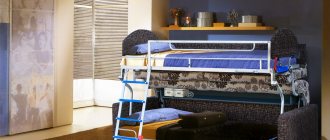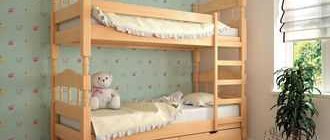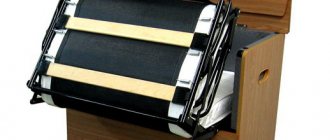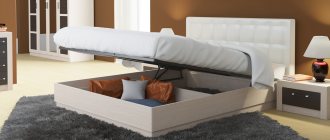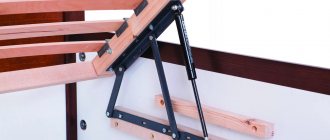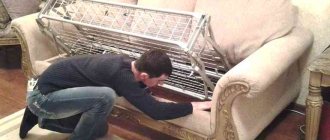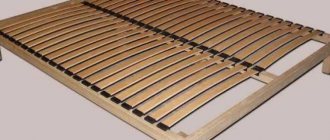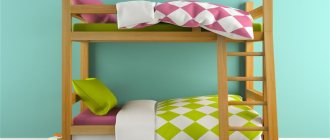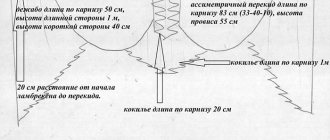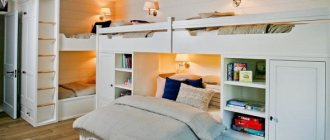The eventful day is over, and you can finally get some sleep. But the insidious bed suddenly begins to make nasty creaking sounds. It seems like a small thing, but it’s unpleasant; the problem needs to be solved somehow. Buying a new bed is not always an option, and it can also creak. So, what to do if your bed squeaks?
Creaking occurs when two parts of a product come into contact; as a rule, this occurs when connections become loose, or due to deformation of the material. Poor assembly results in a completely new bed starting to creak, although this rarely happens. Much more often, creaking does not appear immediately, but over time, when the fasteners weaken during operation, and the wood or chipboard changes in size due to unstable climatic conditions. A spring mattress can also creak when it wears out.
If a wooden bed creaks
The creaking of a wooden bed is primarily due to the characteristics of the material. Wood reacts to changes in air humidity in the room. It becomes damp at high humidity in the absence of heating and dries out in winter when the air is very dry. As a result of such changes, the wooden elements of the bed are often deformed and begin to “walk” relative to each other; even one millimeter of free space between the elements is enough for a creaking to appear. The greater the difference in humidity at different times of the year, the higher the likelihood of squeaks occurring in the near future.
You need to try to find the exact location of the creaking. Start with the mattress, to do this, remove it from the bed onto the floor, crawl on it and listen, if it makes squeaking sounds, then buy a new one. Otherwise, continue searching. Check all fastening connections - this is the most common cause of bed squeaks. Tighten the screws properly. If you cannot fix it securely, secure this joint with a metal angle or bracket. You can try to lubricate the joints of the elements with silicone, paraffin, or, in extreme cases, soap. Lubrication removes friction, which means the squeaking will disappear for a while. If there is a sufficiently large distance between the rubbing parts, lay a piece of felt or felt.
The surest way to eliminate squeaking is considered to be gluing the joints with some kind of elastic glue, such as rubber. It is important to remember to degrease the joints before gluing so that the glue sets well and this work is not in vain. Of course, after such a repair it will no longer be possible to disassemble the bed into parts. But there is a great guarantee of getting rid of nasty sounds.
If you find that the slats are creaking, then proceed as follows. Lubricate the lamella with paraffin or a wax candle. Or pull out the lamella, wrap it with a strip of fabric and insert it back. It happens that it helps to simply swap the slats. It is the lamellas that bear the main load, and over time, cracks may even appear on them. Therefore, if the creaking does not disappear, replace the lamella that has become unusable.
Another radical way to combat the creaking of lamellas is to replace them with two sheets of plywood and carefully screw them to the frame.
The most difficult case is the creaking that occurs from loose bed legs. Repairing old ones or installing new legs is a very difficult process. Often furniture repair specialists offer to cut down the legs of the bed. For the same reason, many furniture factories have stopped producing beds with legs.
The bed creaks - what to do?
Your bed has started to creak, but your plans do not include choosing a new one? Let's try to figure out why the bed creaks and think about what to do when this happens.
There are two main reasons for any bed to squeak: drying out of the wood and loosening of the fasteners. The creaking comes from the friction of two parts of the bed. Since such furniture is often made from chipboard and wood, and their parts are connected using self-tapping screws or special fasteners, over time the parts of the bed begin to gradually shift relative to each other, and creaking occurs. Moreover, it is quite difficult to press the rubbing parts harder if the bed is wooden or made of chipboard.
How to remove the squeak of a wooden bed?
To determine which part of a wooden bed is creaking, you need to disassemble it. Remove the mattress and place it on the floor to check for squeakiness. Perhaps it is not your whole bed that is creaking, but only the springs of the old mattress. In the bed itself, the legs, fastening points, and boards under the mattress can make creaking sounds.
Now you can try to eliminate the unpleasant squeak. First of all, you should try to tighten all the fastenings of the bed: screws, nuts, bolts, and coat these places with wood glue. After this, the glue should dry well and only then can you use the bed. If the fastening is old and it is impossible to tighten it more tightly, install additional metal corners on the back side of the bed base.
You can also lubricate all joints where there is friction with any lubricant: rubber glue, soap, paraffin candle, salidol or even baby powder. A special spray with graphite or silicone is suitable for lubrication. After applying such a coating on the parts of the bed, friction, and therefore squeaking, should disappear.
What to do if the base of your bed creaks, or rather the slats that make it up? In this case, replacing the bed base slats can get rid of the squeak. Alternatively, you can swap them. If the bed continues to squeak, it means that you have not yet found the cause.
Creaking in the bed legs can be eliminated by fixing them more securely. But most often it will not be possible to remove the creaking in this place in the bed. You can try to install new legs, but this is quite a complicated matter and not every owner can cope with it. Therefore, the easiest way is to remove or saw off the legs, and then, with a creative approach, your bed will turn into a modern floor bed.
Eliminating the creaking of a metal bed
Metal squeaks are especially unpleasant. Tighten the fasteners, lubricate the joints of the parts. Some models have front and side walls connected by Click-Clack mechanisms, which quickly become loose and begin to creak. It is better to replace them with ordinary bolts and nuts.
If you find touching surfaces on a metal base that make a creaking sound, cover them with tape.
When a worn armored mesh creaks, it is easier to replace it with any other base. You can treat the springs with WD-40, but this is painstaking work, the results of which will not last as long as you would like.
Air bed creaking
Unfortunately, many air beds squeak a lot. Sound is generated by the contact of rubber surfaces. And it is unlikely that we will be able to completely get rid of this phenomenon, but we can weaken it. To do this, place the air bed on the carpet, cover the mattress with a woolen blanket, and then cover it with a sheet.
Basically, beds begin to make an unpleasant squeaking sound when friction occurs between 2 surfaces.
A squeaking sound in a bed occurs when friction occurs between two surfaces.
At first glance, it may seem that removing the squeak is easy; there is nothing to rub in the bed.
In reality, almost anything can creak. Most often, beds are made of chipboard or wood. The parts are fastened with special fasteners, or self-tapping screws are used for this purpose. The design of such fasteners does not exclude slight movement of parts relative to each other. In addition, materials tend to deform and change in size over time. In this regard, it is very difficult to combine the parts so that there is no relative displacement and it is possible to get rid of the creaking of the bed.
Often the problem occurs in the place where the leg is attached to the side. In this case, the main fastening elements are a bolt and a nut, but you should not overtighten the connection; you may damage the leg or sidewall. And if the tightening is weak, due to the elasticity of the wood, slippage occurs, causing creaking. Moreover, in such a situation, a constant weakening of the connection occurs. There is no point in tightening the nut; in this case, the recess will be pressed down even more. This applies equally to both wood and chipboard.
Why can a bed with an orthopedic base creak?
Why does a bed with an orthopedic base squeak? The main reasons are as follows:
- The culprits may be wooden furniture elements that have dried out over time or natural factors.
- The fasteners become loose and parts of the bed move relative to each other, making a grinding noise. Both wooden and metal models suffer from this.
- Creaking is produced by furniture legs, most often in the places where they are attached to the frame.
Don't despair. Beds, like any product made of wood or metal, are subject to wear and tear and may begin to creak or “moan” over time. Less often, new furniture that was assembled unprofessionally suffers from this problem.
Main options
It should be noted right away that when buying a standard bed, the question always arises of how to get rid of squeaking. But making a bed yourself is not suitable for everyone, so you can still take certain steps to eliminate unpleasant sounds. First of all, you need to glue the joints and joints. For this purpose, you can use rubber glue. According to experts, in such a situation, rubber glue has undeniable advantages. It should be taken into account that any creaking area is characterized by the presence of a strong load and some deformations. Basically, all adhesives form strong seams, but they are still not resistant to deformation.
As for rubber glue, its use produces an elastic seam, which is ideal for this task. First of all, when using rubber glue, a rubber film is formed on the surface to be glued. Even if there is an air bubble and the surfaces mutually shift, there will be no squeaking. Indeed, in this case, surfaces coated with a rubber film will come into contact with each other.
Return to contents
Squeak elimination technique
To eliminate the squeak, you will have to disassemble the bed. The first stage of work is to degrease the joints of the parts. After this, each bonded surface is treated with a thin layer of glue. After this, let the surface dry slightly. After this, the glue-coated surfaces need to be aligned and pulled together in the same way as was done before. Now you need to leave the bed and not use it until you are sure that the glue has dried.
Check the quality of the screws that connect the wooden furniture elements. If necessary, all connections can be strengthened from the inside using steel angles. To process wooden parts at the joints, you can use not only rubber glue, but also graphite lubricant, or use a special spray based on silicone.
In addition, to determine the cause of the squeak, inspect the boards on which the mattress is located. They often sway and become deformed, causing unpleasant sounds. In this case, they can be turned over, and if the desired results are not achieved, then replaced. And finally, it is not the wooden parts of the bed that can make a squeak, but the springs of the mattress. In this case, there is nothing you can do to fix it and you will have to buy a new mattress.
Over time, any wooden furniture begins to emit various sounds, which the owners fight with all available and known methods. It’s especially annoying when the bed you have to sleep on every night starts making sounds. A creaking bed can deprive you of healthy sleep, ruin the quality of sex with your loved one, and with its loud sounds, disturb the sleep of household members even in the next room. How to rid yourself of this minor but unpleasant problem? The very first step is to find out what is causing the bed to squeak.
Options for eliminating squeaks
Depending on where the problem occurs, you can try to come up with a solution. The best and easiest option is to contact the manufacturer and get repairs under warranty. But sometimes a squeak occurs just at the moment when the warranty has already expired. In this case, the issue will have to be resolved independently.
Headboard
Headboards come in two types: monolithic and made of composite parts. The joints always creak, because the sound is the result of friction. There is simply nothing to creak in a monolithic structure.
The prefabricated headboard can be glued or bolted together. In both cases, it is most likely a matter of loose fasteners. For glue, it is enough to use rubber glue, covering the joints of the wood with it. Ideally, you should disassemble the headboard and re-glue all the joints, but if you are not sure that everything will be done neatly, it is better not to risk it. The bolts simply need to be tightened further. If this does not help, then place a washer under the bolt and tighten the fastener.
If the headboard is metal, then friction may occur where the bolts and metal parts of the structure come into contact. The bolts need to be twisted, and the joint should be covered with a gasket made of fabric, rubber or leather.
Then reassemble the structure. If you are careful, the gasket will not be visible, and the squeak will disappear.
Frame
The frame is the biggest problem. They do not sell consumables for repairs. Therefore, it is easier to buy a new base than to mess with the old one. The only option for solving the problem on your own: creaking at the joints of the joists and slats. This means that the wooden parts have moved away from each other and the fastening needs to be strengthened. This can be done by tightening the bolts or gluing the connection. We must not forget that glued grooves can no longer be separated. Rubber glue is suitable for wood. After setting, in addition to its fastening function, the glue will act as an additional gasket, eliminating unpleasant sounds.
Base
The base can be monolithic in the form of a wooden body or in the form of legs. The monolithic base is assembled from several wooden boards, so creaking can only occur in the fastening areas. The same rubber glue will help solve the problem - just coat the joints with it. If the base is bolted, you will have to tighten the fasteners. The same steps must be taken with the legs.
But if sealing the joints does not help, the problem may be an uneven floor. You need to check the floor using a level; if the bed is on an uneven surface, move it to another place and the squeaks will disappear.
Mattress
There is nothing you can do about the mattress. Ripping open the cover and replacing the springs will not work. The only option is to buy a new one. There is an intermediate solution - turn the mattress over. Then the stress points will shift to still untouched areas and the squeaks will disappear for a while. If you use a mattress with dependent springs, the unpleasant sounds will return again after a couple of months. A system with independent elements will last longer: it will last for 2-3 years. But the result will always be the same: the mattress will have to be changed.
If the problem is squeaking in the mattress, you need to buy a new one
Lifting mechanism
The lifting mechanism becomes loose more often than others. With frequent use, the parts begin to move away from each other and the most unpleasant type of squeaking appears - from the friction of metal on metal. The problem must be solved immediately in a comprehensive manner so that you do not have to disassemble the bed again in a few months. First, all rotating mechanisms need to be lubricated. Silicone is ideal as a lubricant.
After this, you need to check the integrity of the bolts. Poor quality fasteners can rust. If the bolts are not rusty, then you need to assemble the structure and raise and lower the bed several times. Is the creak still there? This means that the fastenings are too loose. Sometimes longer bolts are used to solve this problem, but they can scratch things stored inside the bed. Therefore, it is better to add a few additional washers and a rubber gasket. There is no need to be particularly careful when cutting out the pad inside the bed. It would be better to use a piece of rubber with an area twice the size of the bolt head.
Causes of squeaking
A wooden bed may begin to creak due to the natural drying of the material or the simple loosening of fasteners. To find out the real reason, you first need to remove the mattress, throw it on the floor and check for squeakiness. Perhaps the bed has nothing to do with the sound. If you find out for sure that the bed is creaking, you will have to crawl thoroughly on it to determine the exact source of the emanating sounds. These could be old legs, boards under the mattress, places where elements meet. After the creaking place is found, we will try to get rid of the squeaks.
It's not the bed that's creaking, it's the springs.
How to eliminate a squeak?
It is necessary to get rid of the annoying sound immediately, because it brings inconvenience, impairs sleep, and spoils the mood. You need to correctly determine the way to deal with an obsessive problem after you find its source. Let's talk about the most current options in more detail.
The first step is to determine the source of the squeak.
Frame
Dry air negatively affects wood, which leads to its drying out and the formation of gaps. All parts begin to come into contact with each other, move and wear off. For this reason, it is necessary to tighten all fasteners and lubricate them with a special product. If the gaps are large, they will need to be equipped with gaskets, which are made from various materials. It is possible to strengthen a wooden bed frame using furniture corners. Such additional components easily cope with creaking and swaying furniture.
The frame can be strengthened using corners.
Headboards
Most often, problems are hidden in loose fasteners. This problem can be eliminated by strengthening the connecting elements. If the method does not bring the desired result, you need to proceed as follows: you will need to buy and place felt, felt or rubber pads on the mount. Additionally, they can be fixed with glue, but later it will be difficult to disassemble the bed.
Sometimes the problem with squeaking lies in the headboard.
mattress
It is important to find a solution taking into account the type of mattress filling. Budget products often encounter the fact that the springs begin to come into contact with each other. In such a situation, you will have to purchase a new mattress.
The mattress may need to be replaced with a new one.
More expensive products with a spring design in separate cases can be turned over to the other side. This will put less stress on worn components, causing the sound to temporarily stop.
If the mattress is expensive, you can try turning it over to the other side.
Polymer-type fillers also make annoying noise. In most cases, he talks about problems with the tightness of the camera. Such mattresses cannot be repaired, so you will have to buy a new one.
The polymer fillings of the mattress can make noise.
Reasons
The base of the sleeping bed can make noise due to heavy regular load. The easiest way is to move the slats to another place.
To get rid of the squeak, you can move the slats to another place.
Didn't it bring results? Then you will need to perform diagnostics for breakdowns and failure of parts. If damage is detected, it is necessary to replace the components with new ones.
In case of breakdowns, components will have to be replaced.
Next, the fastening is checked, and if necessary, the clamps are tightened and lubricated.
It may be necessary to tighten and lubricate the fasteners.
How to eliminate squeaking
The easiest way is to tighten better all the screws, screws and nuts with which your bed is assembled. In more serious cases, you can additionally secure the joints with metal corners on the inside, and coat all joints with wood glue. You should not use the bed until the glue has completely dried.
If there is nothing to tighten, you can try to lubricate all the joints of the elements with some lubricant. This could be silicone grease, soap, baby powder, candle paraffin, grease. Extreme care must be taken when lubricating to avoid damaging the appearance of the wood furniture. After lubrication, friction disappears, therefore, the squeak disappears.
Another way to solve the problem when the bed creaks is to replace or rearrange the slats that support it. They bear the main load and often quickly become unusable.
Eliminating a squeak is quite easy, the main thing is to find its source
In some cases, the only possible way to get rid of annoying sounds is to simply saw off the legs of the bed. This method is especially relevant if the furniture is not made from solid pieces of wood, but from chipboards that cannot be repaired. Then the bed turns into a stylish floor bed, which, however, is not suitable for every owner.
Wooden furniture is distinguished by high quality production, long service life and luxurious appearance. However, even such household items fail over time for various reasons and begin to present unpleasant surprises to their owners. Considering this, many are interested in what to do about it if a wooden bed creaks and how to fix the problem.
Similar articles:
Causes of squeaking at the bed
If your bed creaks, you shouldn’t despair. This problem can be easily fixed. Even a person far from construction can cope with this process. The main thing is to immediately determine the location of the squeak and understand what its cause is.
In order for the search to be successful, it is necessary to free the bed from all objects, including the mattress, and use force to shake and push all the parts (legs, back and foot, base, etc.). A superficial inspection will tell you where the sound is coming from. Then all that remains is to more carefully examine the squeaky area and understand the exact location of the friction. Most likely:
- connecting parts of the base at the corners;
- places where the legs connect to the frame;
- any of the connections of the slatted or slatted base;
- places where the legs touch the floor.
The reasons why a wooden bed creaks almost always come down to one thing - the material has dried out, cracks have formed at the joints, and adjacent parts begin to rub against each other. The problem becomes especially pronounced if wet raw materials were used during production. As a result, even the purchased bed can creak.
Another common cause of an unpleasant sound can be wear or loosening of the fasteners.
If, after examining the piece of furniture, the creaking does not manifest itself in any way, then the cause must be looked for in the mattress or in the places where it comes into contact with the wooden base.
Once the location of the squeak has been detected, you need to determine a method for eliminating the problem and understand what to do if a wooden bed creaks.
Reasons why a bed with a lifting mechanism creaks
In order to find out why a bed with a lifting mechanism creaks, the product will need to be disassembled and inspected. The most common reasons causing this problem are the following nuances:
- Loose fasteners. If screws, nuts, bolts or other fastening elements become loose, under the influence of gravity and as a result of the movement of people on the bed, the parts begin to rub against each other and cause squeaking.
- Wood drying out. Since beds with a lifting mechanism are mostly made of chipboard and wood, the material begins to dry out, shift and change shape over time. Gaps and distances form between the elements, causing an unpleasant sound.
- Problems with the support part. The problem may arise in the place where the leg is attached to the base of the frame. Most often this occurs as a result of a loose fastener.
- There is a problem with the lift spring. Since the element of the mechanical structure responsible for raising and lowering the berth wears out over time, stretches and loses its elasticity, it can become the main cause of squeaking.
- Incorrect installation of slats. If the grooves are not installed correctly, they begin to rub against the fasteners or fall out. As a result, the slats wear out, and their friction causes squeaking.
In order to determine which part of the bed is creaking, you need to remove the mattress and make movements that loosen the furniture in the direction from the foot to the head. This should be done carefully, without making much effort and listening to the sounds that arise. As a rule, at this moment you can determine exactly where the creaking is coming from. If there are no sounds, you should inspect the mattress, which can also cause squeaking. This can occur due to wear on the springs, especially when the product has been in use for a long time. In this case, it should be replaced.
Determining the source of the squeak
To quickly find the source of unpleasant sounds, you need to ask someone close to you for help.
First you need to simulate a night's sleep: lie on the bed, turn in different directions, and at this time the assistant will listen to the place of origin of the sounds.
If a wooden bed creaks when a person moves in a lying position, then the source may be the joints of the legs and the base of the frame, as well as the corner joints of the lounger. Problems can also arise in wooden planks. Even unused slats that are not screwed securely will begin to creak from the first day.
An uneven floor causes the legs to constantly shift, producing an unpleasant grinding noise. Old floorboards may creak, and the sound may seem to be coming from the bed.
If, after a long search, we couldn’t find anything on the furniture itself, we move on to the mattress. Since he’s just lying on the floor at this time, let’s lie down and try to detect extraneous sounds inside him. This means the problem is in the springs.
The final source of squeaking is where the mattress meets the base of the bed. To detect it, you need to return the mattress to its place and carefully roll on it. The source of the noise cannot be detected immediately, but only after the mattress is installed in the position that is problematic.
After all search methods have been implemented, you need to proceed to the last stage - eliminating the creaking of a wooden bed.
How to determine the source of a squeak
To eliminate squeaking, it is important to understand which element of the bed needs repair or replacement. The sequence for determining the source of the squeak is given below.
Step 1. It is more convenient to examine the bed together. Sit down, lie down on the bed, get into a position where you can hear a creaking sound. At this time, the assistant can identify the problem area by ear.
Try to find the source of the squeak by ear.
Step 2: Rock the bed from side to side in all directions and also listen to where the sound is coming from.
Rock the bed from side to side
Step 3: Remove the mattress from the bed and place it on a flat floor.
Remove the mattress from the bed
Step 4. Try sitting and lying on the mattress, and also rock the bed without a mattress. By ear, try to determine which part of the bed is creaking.
Checking the mattress and frame separately
Step 5: If the bed frame and mattress do not squeak, the problem may be with the slatted base. The slatted base consists of wooden slats secured with lath holders to a frame made of metal or wood. Creaking usually appears at the place where the slats are attached. To check, inspect the slats and press each one with your hand.
Step 6. If you find out that the problem is in the wooden frame, inspect all joints, check the tightness of the mounting screws or self-tapping screws. Fine wood dust, abrasions and chips on the surface of the wood will indicate wear of individual elements - they are usually the source of creaking.
Checking the reliability of frame fastenings
Step 7. A bed with legs may also creak at the joints between the frame and the legs. You can find out this by ear by rocking the bed with the mattress removed.
Attaching the leg to the bed
Step 8. For beds with a lifting mechanism, the source of squeaking is often the mechanism itself. As a rule, it cannot be repaired and requires replacement.
Bed with lifting mechanism
Advice! Before you start disassembling the bed and repairing it, make sure that it is the bed that is creaking, and not the floor underneath it!
Remove squeaks without disassembling the bed
The easiest way to eliminate the creaking of a wooden bed is to create a soft pad or strong support. You need to insert a soft object into the space between the headboard and the wall. Sometimes this helps soften the contact between two hard materials. On the free side, you need to support the foot with a chest of drawers or a heavy stand. This will help fix the furniture in the desired position and prevent its movement.
Such actions do not always help and do not last long. Therefore, to prevent the bed from creaking, you will have to use tools.
First, the fastening elements are tightly tightened using open-end or adjustable wrenches or screwdrivers. Most often, access to them is carried out without disassembling the furniture, but sometimes additional fastening in the form of metal corners and gluing joints may be necessary.
Do not neglect the intermediate method of coating in the connection of the frame, legs, headboard and foot. Even if it is not needed now, such processing will not be unnecessary.
It is necessary to consider how to get rid of bed squeaks if the cause is worn slats. First you need to swap the central and outer elements to relieve the stress on the tired wood. If this does not help, you will have to change the lamella.
Dismantling the bed
The most radical method of eliminating the creaking of a sleeping bed is to completely disassemble it and process each part separately. To do this you will need the following tool:
- wrenches and screws;
- Screwdriver Set;
- screwdriver or drill;
- brushes, rollers, sandpaper;
Important: you need to immediately prepare the necessary fastening consumables, metal corners, rubber glue and lubricants (wax, paraffin, soap, ski or graphite grease, etc.).
To easily unscrew the fasteners, you must first understand which of them are used:
- Planks with hooks or a special bed screed can be disassembled by simply detaching the parts from each other.
- The screw coupler is intended for end connection. Consists of a screw and a nut. Unscrews with a hex key.
- The canonical tie is unscrewed with a Phillips screwdriver.
- Euroscrew fastening is a metal screw screwed into a pre-prepared hole. Removable with a hex wrench.
- Connections using dowels or wooden cartridges coated with glue are more difficult to remove. To do this, you need to gradually insert a thin object (a screwdriver or the end part of a knife blade) into the gap between the fastened parts and move them apart until the entire dowel appears outside. Then its free part is grabbed with pliers and pulled out.
Disassembling the bed begins with removing the foot and headboard. Then you need to disconnect the base from the frame. If necessary, disassemble the components themselves, detach the slats, legs, etc.
As you disassemble, carefully inspect all fasteners on the bed. If a damaged thread is found, replace the screw or bolt with another one. It is recommended to replace the removed dowel.
To create a strong, unified structure, before assembly, all parts and joints are treated with rubber glue. Before gluing, it is recommended to degrease the wood surface.
What do you do with old furniture?
| Causes of bed squeaking. What can be done to get rid of the nasty sound? What to do? How to eliminate a squeak? (10+) Why does the bed squeak? What to do? |
Causes of bed squeaking
The cause of squeaking is usually friction between two surfaces. Creaking occurs when one part rubs against another. It would seem, why rub in bed? But in fact, literally everything in the bed creaks. Most beds are made from wood or chipboard. The parts are fastened with self-tapping screws or special fasteners. This fastening does not prevent slight movement of one part relative to another. Since both wood and chipboard tend to deform and change their dimensions over time, it seems very difficult to securely press one part to the other so that there is no relative displacement, and therefore creaking.
Pay attention to the diagram. This is the attachment of the bed leg to the side - top view. A nut and bolt hold the leg to the side. But you cannot tighten such a connection too much, as otherwise you can break the sidewall or leg. And if the tightening is not very strong, due to the elasticity of the wood, slipping will occur and creaking will occur. The connection will also gradually weaken. Tightening the nut is useless, as it will simply push the recess into the wood or chipboard even deeper.
Eliminating mattress squeaks
First, check if the mattress is lying flat. Even such a stupid reason can cause a grinding noise.
Inexpensive mattresses with spring filling are characterized by the problem of spring contact. Friction leads to an unpleasant sound.
The cause of sound in an all-polymer mattress is the poor quality of materials. A faulty mattress should be replaced immediately.
If you don't have a lot of money, pay attention to well-known inexpensive furniture stores. “Ikea” is famous for its affordability and originality of design solutions. If the purchase was recent, contact the manufacturer for warranty information. In this case, you are required to return the money or replace the defective product with a working one.
Eliminating the creaking of a wooden bed
What to do? How to proceed? How to eliminate squeaking? It is almost never possible to completely eliminate bed squeaks and get rid of the nasty sound in standard commercial beds. To prevent the bed from squeaking, you need to do it yourself, then you will be guaranteed against squeaking. How to make a bed without squeaking yourself, with your own hands.
But still, something can be done. The joints, similar to those shown in the figure, and the joints of the walls need to be glued. I do this with rubber glue 88 (Luxe). The advantages of rubber glue in this situation are undeniable. Firstly, the places where the bed creaks are characterized by heavy loads and some deformations. Most adhesives form a strong seam, but it is susceptible to deformation, since the seam is not elastic. Rubber glue gives an excellent elastic seam. Secondly, rubber adhesive forms a rubber film on the bonded surfaces. Even if there is an air bubble there and mutual displacement of the surfaces is observed, then there will be no creaking, since the surfaces covered with a rubber film will rub against each other.
To eliminate the squeak, the bed must be disassembled. Degrease the joints of parts. Next, apply a thin layer of glue to each surface to be glued. Let it dry a little. Then the surfaces, each of which is covered with a drying film of glue, are combined and tightened in the same way as they were previously secured. Read here how to re-screw a self-tapping screw correctly. Leave the bed alone until the glue has completely dried. It is better to dry for 24 hours, during which time maximum strength will be achieved. If you rush, you can ruin everything.
Attention!
A bed taped in this way will be very difficult to disassemble.
Thorough elimination of squeaks
If you are not planning to replace the bed, you should try to strengthen its elements as securely as possible. Usually the frame is strengthened with glue in several stages:
- disassembling the frame;
- wiping parts, removing dust and dirt;
- degreasing the surface;
- applying glue to holes and joints;
- connecting parts, assembling the frame;
- leaving the bed until completely dry.
It is also possible to strengthen the structure of the bed with furniture corners - they are attached to the weakest joints and firmly fixed.
